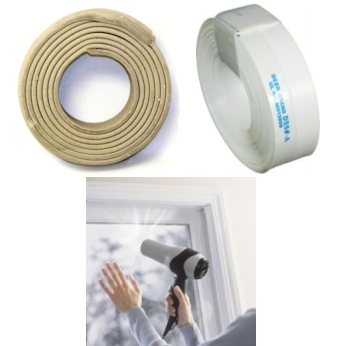
In a home that lacks proper insulation, air leaks occur year-round. However, they are most easily felt during the winter months. For example, if you sit at a window that is poorly insulated, or place your hand to it, a draft can be felt coming into the home. With drafts come less comfort in the home, and more money spent on heating it. Weatherproofing windows can be done with tools such as rope caulk, v seal weatherstripping, and interior storm windows. These are all simple to install and capable of sealing air leaks without breaking the bank.
Rope caulk is simply window putty that comes on a roll. Of the three tools, it is the simplest to install. To install, take a piece of the caulk, and press it into the window gaps with your fingers. Be sure to go around the entire window for the best results. The amount of rope caulk necessary depends on the size and number of windows that require insulation. Rope caulk is available in 35 ft., 45 ft., and 90 ft. rolls in both brown and grey, and costs between $2.50 and $5.80.
V seal weatherstrip also comes on a roll, and is made of pre-scored polypropylene that has an adhesive backing on one half of it. Weatherproofing windows with this tool is done by first cleaning the surface where the sealant will be placed. Then, using a pair of scissors cut the v seal into the desired length, and press into place using your fingertips. The shape that is made with the sealant is a “V” shape, hence the name. V seal weatherstrip comes in brown and white rolls of 17 ft. and 180 ft., and costs between $4.50 and $23.00.
Interior storm windows cover the entire window to seal out drafts. By creating dead air space , the kit increases insulating R-Value up to 90%. Window kits cost between $5.99 and $13.00, and are the most difficult of the 3 to install. Exact instructions depend on the type of kit acquired, but here are a few basic steps that are required for installation of interior storm windows:
- Clean the window surface.
- Apply tape to the designated places on the window.
- Place the plastic film over the window, and lightly against the tape.
- Lightly stretch the film, making sure to not stretch too much.
- Use a hair dryer to stretch the film. Do not let the dryer touch the film. This also gets rid of any wrinkles.
- Cut off any excess film.
Using either of these tools, you can quickly seal out window drafts, reducing the amount of energy loss that occurs in the home. In addition, weatherproofing windows will help reduce the amount of money spent on heating the home, as windows account for 10%-25% of all home energy loss.
